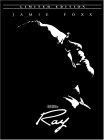
To a simple man, this movie would appear as if the director could not find a light to expose Ray Charles under. One second Ray was a sympathetic tortured soul, then an emotionally abusive man, and then as a musical genius lost in his keyboard. But to me, this portrayal smacked of realism. As people are not, and shall not ever be two-dimensional characters on the silver screen. They have their moments of weakness, their moments of passion, and their moments of cruelty. And that is where this film found its strength, in contrast and comparison.
Much like the multiple facets of Ray’s personality, the lighting and coloring of the movie fell into multiple tones and hues. There were scenes of stark contrast, glossy black laminate with a blinding light shining on it obscuring half of the shot in its glare. The flashback sequences to Ray’s childhood were full of bright glorious color. Georgia’s red clay on a little boy's knee’s, a rainbow of glass bottles dangling from tree branches, and luscious flowing fields of tall green grass.
There was a gritty realism to this film that most period pieces lack. Ray Charles came to stardom during the era of the “Jim Crow” laws, and this movie did not gloss that over at all, and neither did it condemn it. There was segregation in the South, and in this movie it was not there to make a statement, it was there because at that time it belonged there.
The segregation was used to paint a picture of a different world then we New Englanders have grown up with. Not just the colored water fountains, the separate seats on the bus, and the colored rest rooms but an entirely different way of life, a different way of behavior. There was no “enlightened white man” to stand up to the “oppressive red necks”, because there wasn’t one. They were Boys, and the white man was Sir. Towards the end of the movie there was a clumsy scene that seemed to me to be an afterthought of the director. Almost as if the scriptwriter came to him one night and said
“Hey Didn’t Ray get banned from Georgia for life for doing…something? And didn’t it involve the civil rights movement?” Then the director might have chimed in with something along these lines.
“Yeah he did, and they rescinded it in 1979. Now that would make a great ending to my movie!” Fortunately Jamie Foxx portrayed a fantastic Ray Charles, even down to the slightly slurred words and the infamous “junkie itch”. He was able to carry the few less then poetic scenes of the film through on his sheer presence alone.
My favorite aspect of this film (other than the music that is) was the look of this film. The casting director must have traveled back in time to find the extras for this cast. There was a difference in body type for each era of the film. A scrawny underfed mother for Ray’s childhood, a trio of curvaceous backup singers for his stage, and spit polished L.A. lawyers who somehow appeared comfortable in the hideous fashions of the early 1960’s.
Ray Charles lived on this mud ball spinning in space for 74 years, that’s a lot of story to cram into a single film. The story focuses on a few aspects of Ray’s life, and blatantly skips decades of his life. It would have been impossible to show an audience everything there was about the man, so the director showed us his genius and his frailty. Reminding us that for all of his gold records and Grammys, he still put on his socks one at a time, and had to be paid in singles so that he knew the club owner wasn’t cheating him.

No comments:
Post a Comment